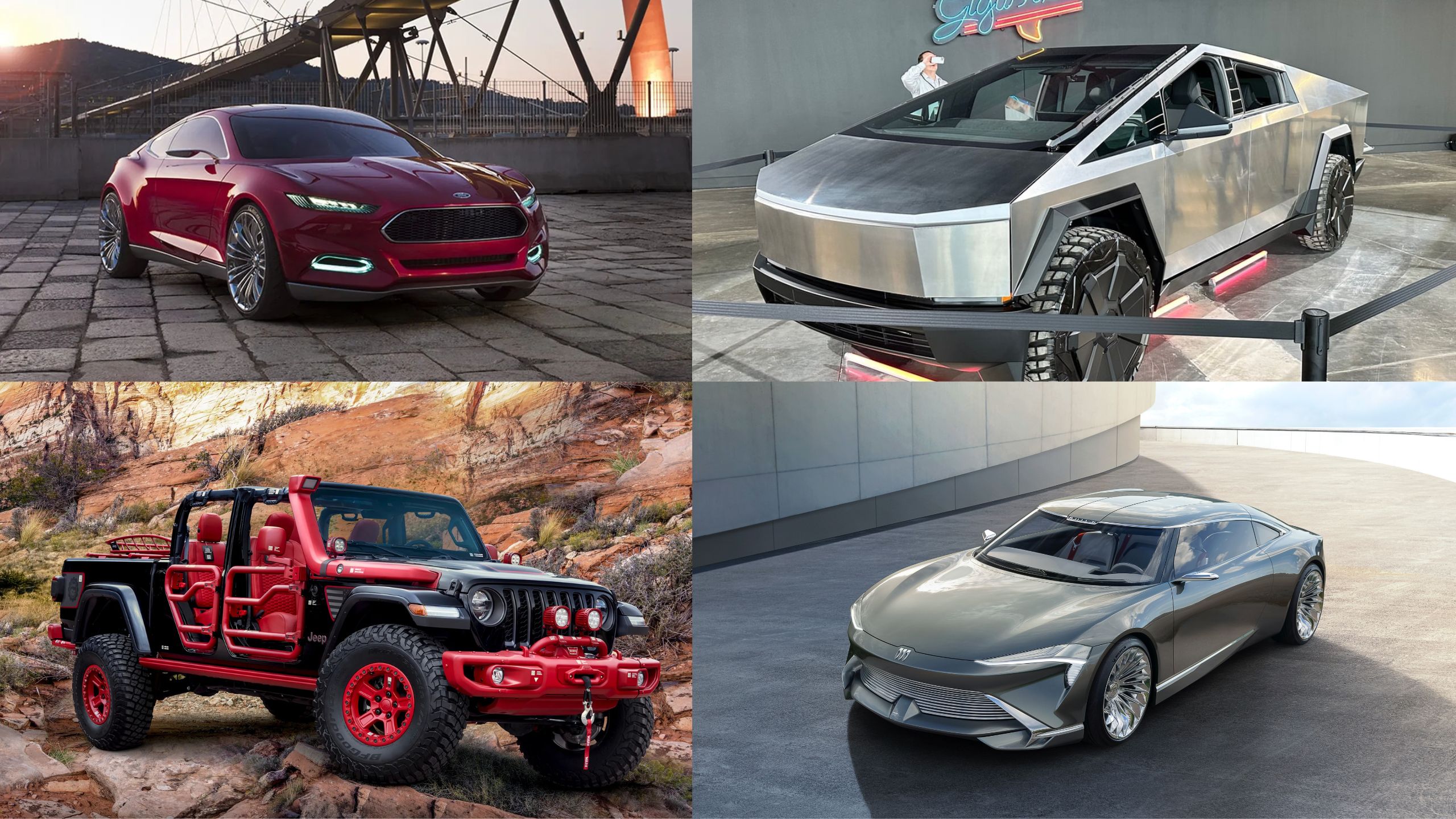The American automotive world is undergoing a radical transformation, and concept cars serve as a visionary look into the future.
These rolling laboratories of innovation represent the boldest ideas from Detroit to Silicon Valley, merging cutting edge technology with distinctly American design philosophies.
From electric powertrains that redefine performance to autonomous systems that reimagine the driving experience, these concept vehicles push boundaries while addressing pressing challenges of sustainability, connectivity, and urban mobility.
They serve as crucial indicators of how American automakers are positioning themselves in a rapidly evolving global market.
Some concepts hint at near-production models, while others explore more distant possibilities, but all share a common thread: they represent American ingenuity and ambition in automotive design.
As traditional manufacturers compete with emerging startups and tech giants entering the automotive space, these concept cars not only showcase technological prowess but also reflect cultural shifts and changing consumer expectations. Together, they paint a compelling picture of America’s automotive future.
1. The Cadillac Celestiq Show Car
The Cadillac Celestiq represents a bold return to bespoke luxury for General Motors’ flagship brand, reimagining American premium transportation for the electric age.
First revealed as a show car before transitioning to a limited-production ultra-luxury EV, the Celestiq embodies Cadillac’s ambition to reclaim its historical position as “The Standard of the World” through uncompromising craftsmanship and technological ginnovation.
Celestiq’s design draws inspiration from iconic models like the 1957 Eldorado Brougham while establishing a thoroughly modern aesthetic language.
Its fastback silhouette conceals an expansive wheelbase that prioritizes rear passenger comfort, while the dramatically sloping roofline integrates seamlessly with a hatch-style rear opening.
The most striking exterior feature remains the illuminated grille and lighting elements that create a theatrical welcome sequence, establishing a new visual signature for electric Cadillacs.
Inside, the Celestiq demonstrates a return to handcrafted luxury with each vehicle destined to be customized to individual client specifications.
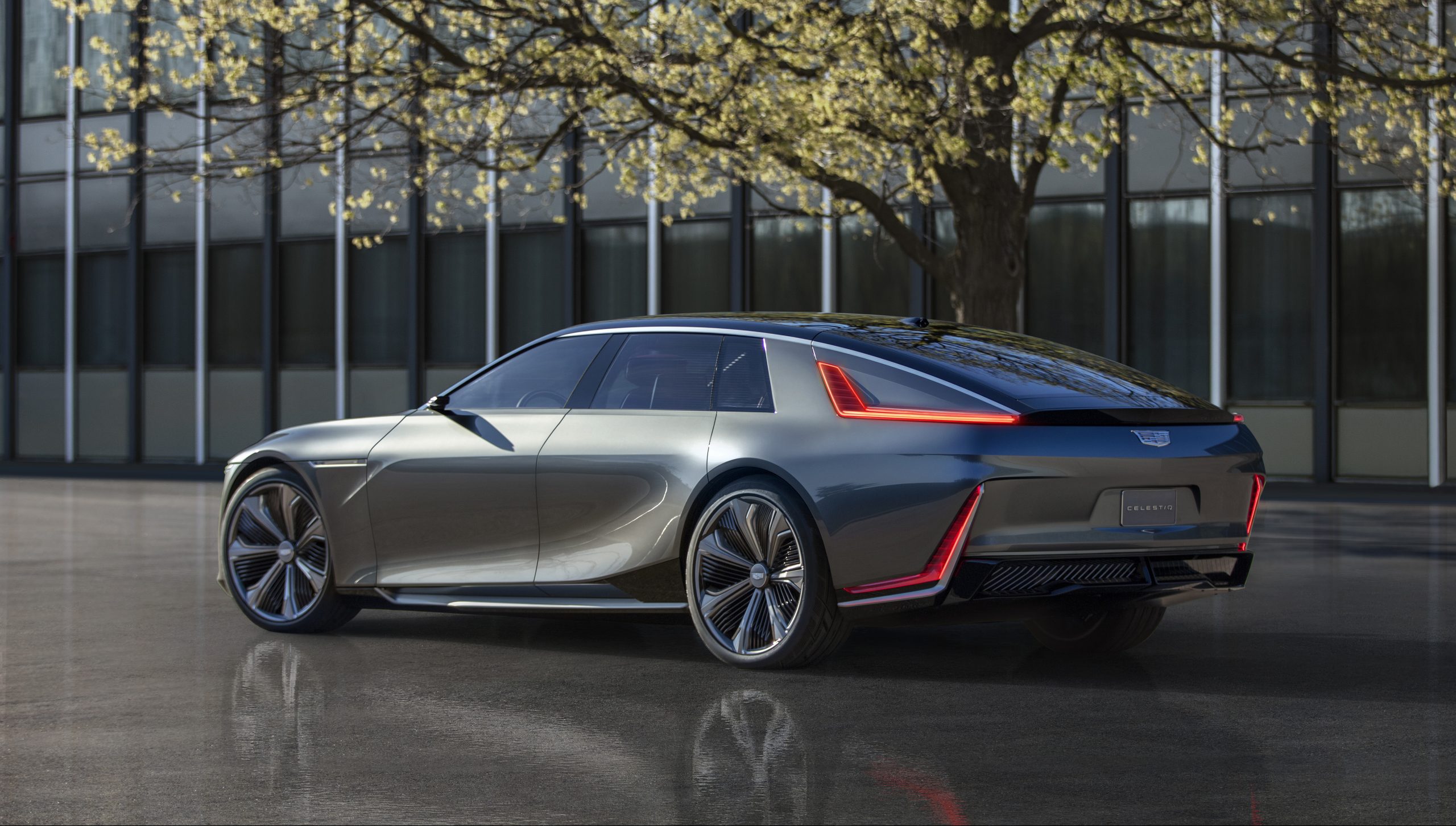
The cabin’s centerpiece is a 55-inch digital display spanning the entire dashboard, complemented by four additional screens throughout the interior.
Smart glass roof panels can be individually adjusted for transparency by each occupant, demonstrating Cadillac’s focus on personalized comfort zones within a shared space.
Technologically, the Celestiq showcases GM’s Ultium battery platform with expected range exceeding 300 miles and advanced driver assistance systems including Ultra Cruise, GM’s next-generation hands-free driving technology.
The commitment to American manufacturing is evident in GM’s $81 million investment in hand-built production facilities at the Global Technical Center in Warren, Michigan.
The Celestiq represents more than just a vehicle; Cadillac states that American luxury can compete with European and Asian ultra-premium offerings through a combination of cutting-edge technology, bespoke craftsmanship, and distinctly American design sensibilities.
2. Ford Evos Concept
The Ford Evos Concept stands as a pivotal design study that has profoundly influenced the American automaker’s global design language while exploring the integration of cloud connectivity and adaptive vehicle personalities.
First revealed at the Frankfurt Motor Show, the Evos presented Ford’s vision for bridging the gap between traditional automotive design and the digital ecosystem that increasingly defines modern consumer experiences.
The Evos’s fastback silhouette introduced a dramatic departure from conventional vehicle segments, blending elements of sedans, crossovers, and sports cars into what Ford termed a “personal mobility gateway.”
Its most distinctive design elements include butterfly doors that open upward to reveal a four-seat interior, a dramatically sloping windshield that extends into a glass roof, and an aerodynamic profile that would later influence production vehicles like the Mustang Mach-E and the latest generation Escape/Kuga.
Beyond its striking appearance, the Evos pioneered Ford’s concept of the “personal cloud” a vehicle that knows driver preferences, habits, and even health data.
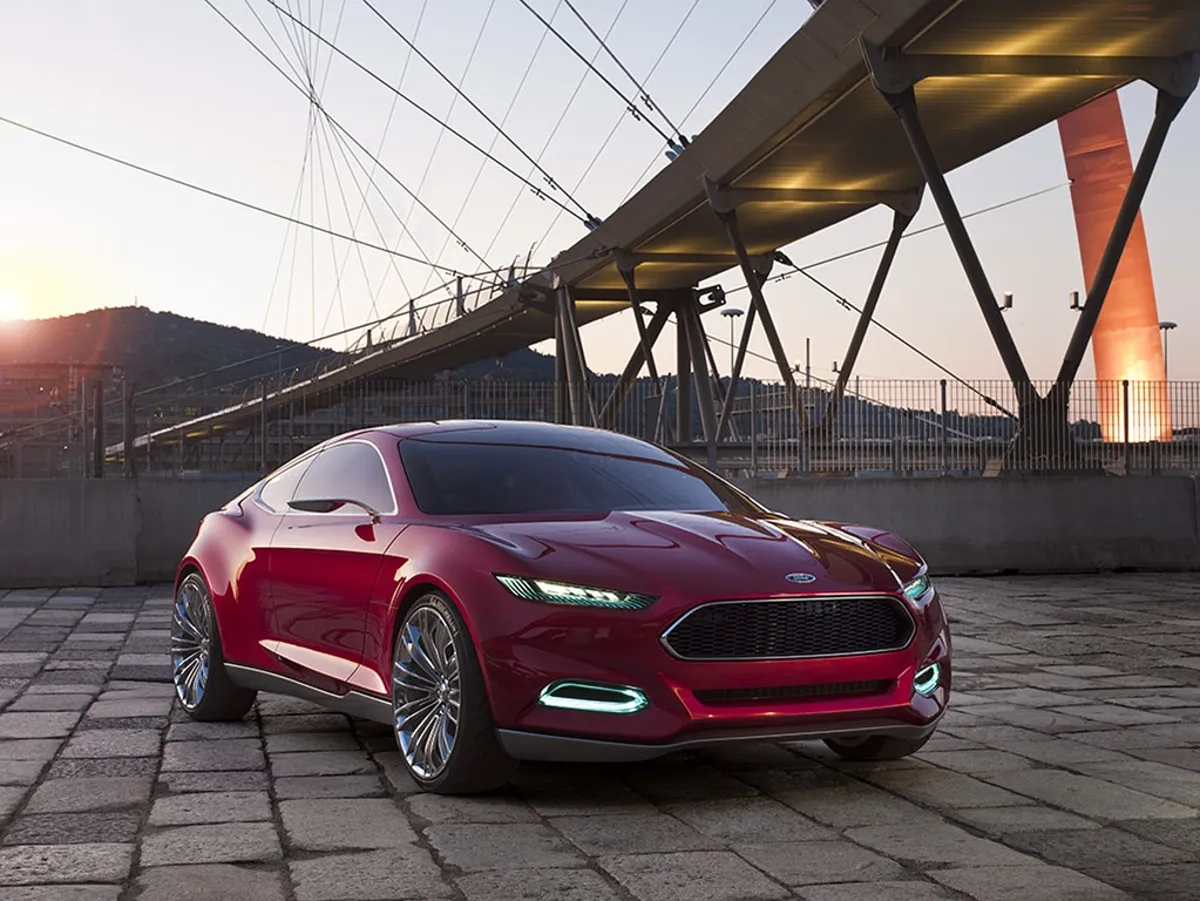
The concept demonstrated how cloud connectivity could allow the vehicle to adapt driving characteristics based on road conditions, traffic patterns, and even the driver’s work schedule.
It could, for example, automatically adjust suspension settings for winding roads it knows the driver enjoys while reserving battery power for zero-emission zones on the commute.
The interior showcased a multifunction interface with adaptive displays spanning the entire dashboard, allowing information to flow between driver and passengers or be configured based on driving modes.
This driver-centric yet socially oriented cockpit design represented Ford’s recognition that future vehicles would serve as extensions of both personal and shared digital ecosystems.
Although the Evos never reached production in its concept form, its influence permeates Ford’s current vehicle lineup through the “Energi in Motion” design philosophy.
More importantly, its vision of seamless cloud connectivity and adaptive vehicle personalities formed the foundation for Ford’s current connected vehicle strategy, including over-the-air updates and integration with digital assistants like Amazon Alexa.
3. Tesla Cybertruck Prototype
The Tesla Cybertruck prototype represents perhaps the most radical reconceptualization of the American pickup truck since the vehicle category’s inception.
Revealed in 2019 by Elon Musk in a presentation that instantly became legendary for both the vehicle’s unconventional design and a demonstration gone awry, the Cybertruck challenges virtually every convention of automotive design while promising unprecedented functionality.
The Cybertruck’s most immediately striking feature is its angular exoskeleton composed of ultra-hard 30X cold-rolled stainless steel the same alloy developed for SpaceX rockets.
This unibody construction eliminates the traditional body-on-frame approach of conventional pickups, creating what Tesla calls a nearly impenetrable shell.
The planar surfaces and sharp edges resulted from both material constraints (the stainless steel can’t be easily stamped into curves) and Musk’s fascination with cyberpunk aesthetics and vehicles like the Lotus Esprit submarine from “The Spy Who Loved Me.”
Functionally, the Cybertruck prototype promised remarkable capabilities: a payload capacity exceeding 3,500 pounds, a towing capacity of over 14,000 pounds, and an adjustable air suspension providing up to 16 inches of ground clearance.
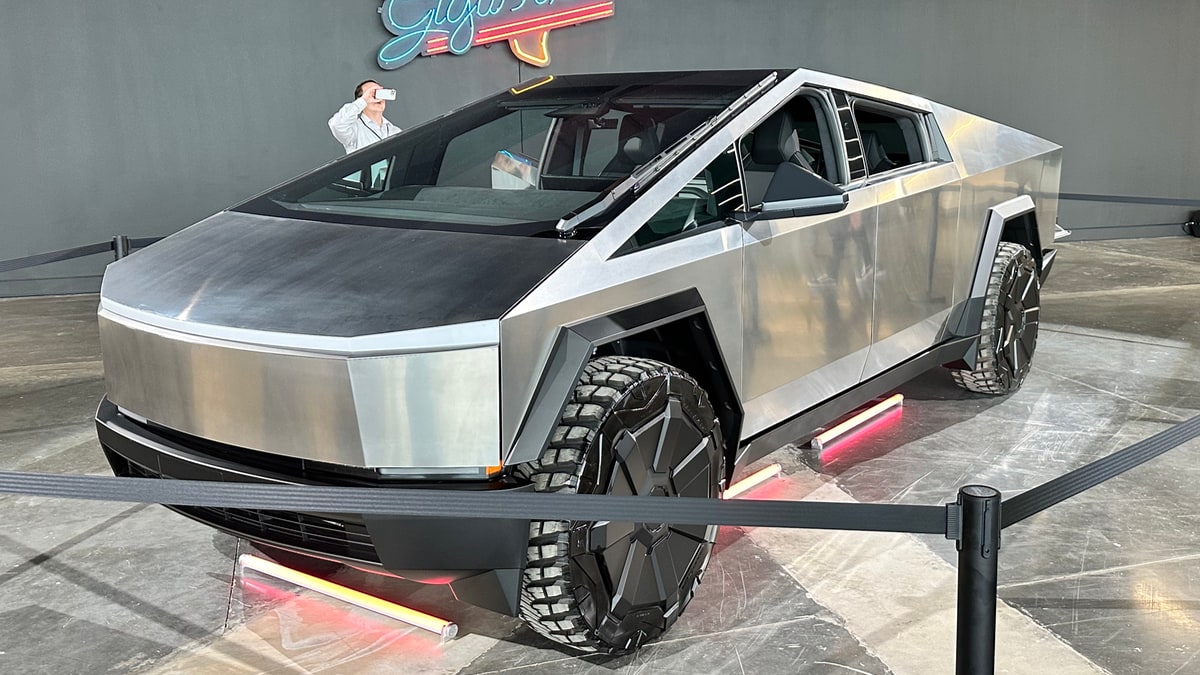
The 6.5-foot cargo bed (or “vault” as Tesla calls it) features a built-in ramp, integrated 110V/220V power outlets, and a sliding tonneau cover robust enough to stand on.
Inside, the minimalist interior centers around a 17-inch touchscreen and a yoke-style steering wheel, seating six adults across two rows.
The nearly quarter-inch thick armor glass windshield and windows (despite the infamous demonstration mishap) promised unprecedented damage resistance, while the ultra-hard exterior eliminated the need for paint, potentially reducing environmental impact and maintenance.
Beyond its polarizing aesthetics, the Cybertruck represents Tesla’s ambition to reinvent the most quintessentially American vehicle category through a zero-emissions powertrain offering up to 500+ miles of range and supercar-rivaling acceleration.
While the production version has seen modifications from the original prototype, the Cybertruck stands as a bold statement that American automotive innovation need not be constrained by traditional design languages or manufacturing approaches.
4. Jeep Magneto 2.0
The Jeep Magneto 2.0 concept represents a fascinating exploration of how electrification might enhance rather than compromise the off-road capabilities that define America’s most iconic 4×4 brand.
Revealed as an evolution of the original Magneto concept, this experimental Wrangler-based EV pushes the boundaries of electric propulsion in extreme off-road scenarios while maintaining the rugged, go-anywhere ethos that Jeep enthusiasts demand.
Most remarkably, the Magneto 2.0 retains a manual transmission an unprecedented approach in modern EVs pairing a custom axial flux electric motor with the Wrangler’s six-speed manual gearbox.
This unconventional drivetrain allows for precise torque control in technical off-road situations while delivering a driving experience that feels familiar to traditional Jeep enthusiasts.
The driver can hold the vehicle at idle simply by modulating the clutch, replicating the experience of a conventional powertrain but with the instant torque characteristics of electric propulsion.
Visually, the Magneto 2.0 maintains the recognizable silhouette of the Wrangler while incorporating distinctive design elements that signal its experimental nature.
A custom lightweight hardtop, carbon fiber B-pillars, and a carbon fiber hood with a blue-tinted transparent window showcasing the electric motor create a futuristic appearance without sacrificing the functional design elements essential to serious off-roading.
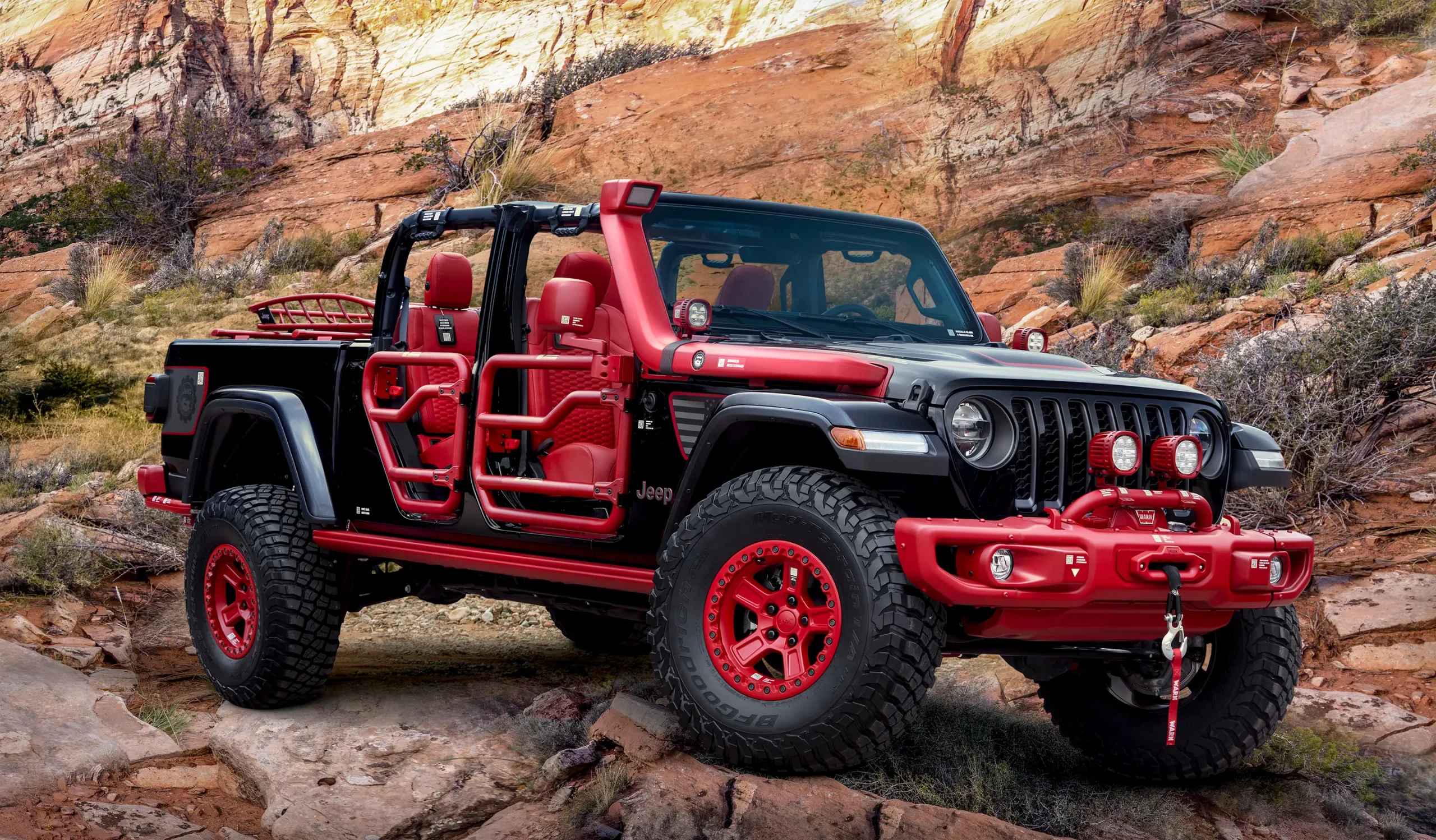
The raised stance accommodates 40-inch off-road tires mounted on 20-inch wheels, while custom front and rear bumpers improve approach and departure angles.
The powertrain delivers staggering performance for an off-road vehicle: the custom-built axial flux motor can sustain 850 lb-ft of torque and 625 horsepower, enabling 0-60 mph acceleration in just 2 seconds when in “maximum attack” mode.
Four lithium-ion battery packs with a combined capacity of 70 kWh are distributed throughout the chassis to maintain optimal weight distribution, while 800-volt architecture enables faster charging.
Beyond performance metrics, the Magneto 2.0 represents Jeep’s exploration of how electrification might actually enhance the brand’s core capability values.
The instant torque delivery of electric motors proves advantageous in rock crawling scenarios, while the potential for individual motor control at each wheel could revolutionize off-road traction systems.
As a rolling laboratory rather than a production preview, the Magneto 2.0 demonstrates that American off-road culture can embrace electrification without sacrificing the mechanical character and capability that define legendary American 4×4 vehicles.
Also Read: 12 Luxury Electric Sedans That Rival Gas-Powered Alternatives
5. Lincoln Star Concept
The Lincoln Star Concept represents the Ford luxury division’s ambitious vision for reinventing American luxury in the electric age, emphasizing serene spaciousness and thoughtful technology over traditional opulence.
Revealed as a preview of Lincoln’s electric future, the Star introduces a new design language specifically developed for the unique packaging opportunities that dedicated EV platforms provide.
The Star’s exterior design balances progressive futurism with recognizable Lincoln DNA. The illuminated crystalline front fascia replaces the traditional grille with an intricate light display that serves both aesthetic and communicative functions.
The concept features a dramatically sloping, transparent hood that reveals storage space where an engine would traditionally reside. The fastback silhouette incorporates what Lincoln calls a “coast-to-coast” curved display spanning the dashboard, while the rear features a uniquely cantilevered glass structure creating an airy, pavilion-like atmosphere.
Interior innovation defines the Star Concept’s most revolutionary aspects. The cabin is arranged as a “third space” – neither home nor office but a sanctuary designed for rejuvenation.
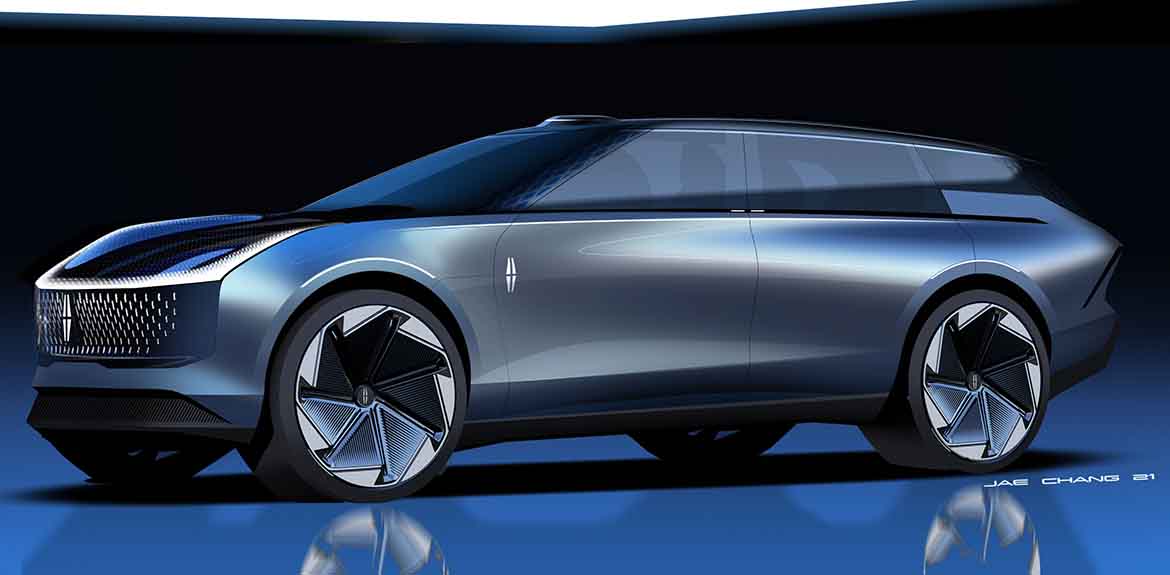
The front seats can rotate to face rear passengers in autonomous driving modes, while the rear features reclining lounge chairs with leg rests.
Most distinctively, the Star introduces Lincoln’s “Rejuvenation Modes” that combine customized interior lighting, display animations, scent diffusion, and soundscapes to create three curated sensory experiences: Coastal Morning, Mindful Vitality, and Evening Chill.
Technologically, the Star showcases Lincoln’s vision for digital experiences and advanced driver assistance. The vehicle recognizes occupants as they approach, automatically adjusting settings to personal preferences.
The curved dashboard display features digital versions of Lincoln’s traditional instrument graphics, while a smaller center console screen provides access to vehicle functions and comfort controls. An intelligent storage solution between the front seats includes a hidden compartment for tech devices with wireless charging.
While Lincoln has not confirmed specific powertrain details, the Star Concept is built on a dedicated battery-electric architecture enabling both rear and all-wheel drive configurations.
More importantly, it represents Lincoln’s belief that American luxury in the electric era should focus on creating sanctuary-like environments through thoughtful integration of technology rather than ostentatious displays of status a philosophy that distinguishes it from both European luxury competitors and Lincoln’s historical approach.
6. Chrysler Airflow Concept
The Chrysler Airflow Concept revives a historic nameplate from the 1930s to signal a similar commitment to aerodynamic innovation and forward-thinking design for the electric age.
As Chrysler’s vision for its all-electric future, the Airflow represents a pivotal moment for the brand as it attempts to redefine itself within Stellantis’s expansive portfolio, promising a distinctive American approach to sustainable premium mobility.
The Airflow’s exterior design establishes a new visual identity for Chrysler while prioritizing aerodynamic efficiency. The front features a dramatically thin light blade illuminating the width of the vehicle, complemented by a backlit Chrysler wing logo.
The fastback profile creates a continuous sweep from the A-pillar to the rear deck, while pronounced shoulders above the wheels establish a powerful stance.
Most notably, the Airflow demonstrates a more sophisticated and premium design language than contemporary Chrysler vehicles, signaling the brand’s upmarket aspirations.
Inside, the Airflow showcases Chrysler’s vision for a connected digital ecosystem through the STLA Brain electrical/electronic architecture and STLA SmartCockpit user experience.
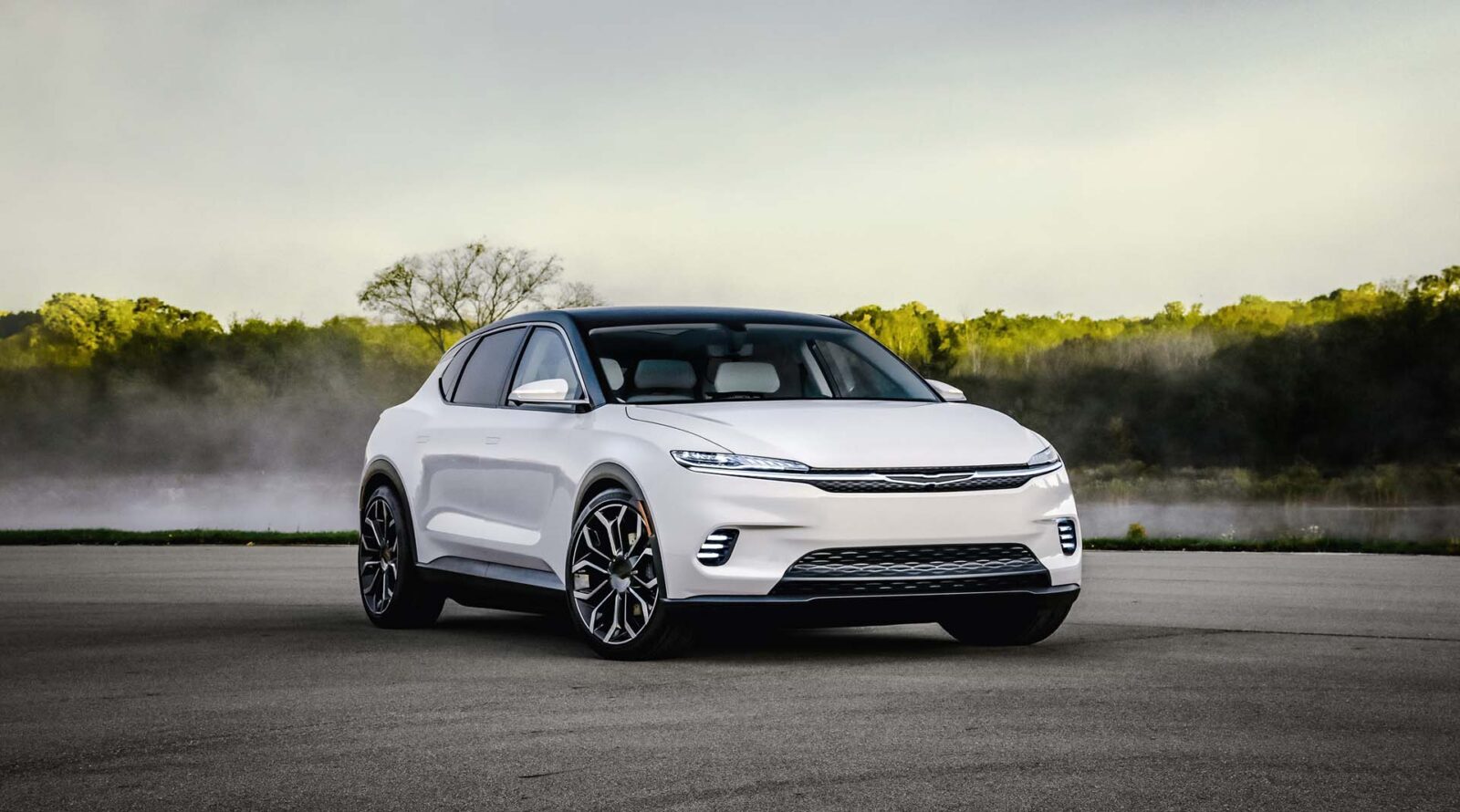
The cabin features individual screens for each occupant including rear passengers that can be customized, shared between passengers, or synchronized for group experiences.
Sustainable materials including vegetable tanned leather alternatives, recycled materials, and responsibly sourced wood demonstrate the brand’s commitment to environmental consciousness beyond the zero-emissions powertrain.
Technologically, the Airflow introduces STLA AutoDrive, offering Level 3 autonomous capabilities that allow for hands-off operation in certain conditions.
The dual-motor electric powertrain delivers all-wheel-drive capability and a projected range between 350-400 miles. Over-the-air update capability ensures the vehicle’s technology remains current throughout its lifecycle.
The Airflow Concept represents more than just Chrysler’s first electric vehicle it embodies the brand’s strategy for survival in a rapidly transforming automotive world.
By blending distinctly American design sensibilities with European technical expertise from parent company Stellantis, Airflow aims to carve out a unique position between mainstream and luxury segments.
While production plans remain fluid, Chrysler has committed to launching its first production electric vehicle by 2025, with the Airflow providing strong indications of both the technological foundation and design direction this crucial model will take.
7. GM Ultium-Based Buick Wildcat EV Concept
The Buick Wildcat EV Concept marks a dramatic reinvention for General Motors’ near-premium brand, reviving a historic performance nameplate to signal a bold departure from Buick’s recent design language.
As the first concept to showcase Buick’s dedicated EV design language before the brand transitions to an all-electric lineup, the Wildcat represents both a stylistic revolution and a strategic repositioning within GM’s brand hierarchy.
The Wildcat’s exterior design abandons Buick’s previous styling cues in favor of a dramatically low-slung, sports coupe silhouette with 2+2 seating.
Most distinctive is the sharply angled front end featuring micro-LED lighting elements and an illuminated Buick shield logo. The semi-swing doors open dramatically outward while the roof section simultaneously raises slightly a theatrical entry and exit experience reflecting Buick’s ambition to create vehicles with distinctive character.
The sweeping body sides lead to muscular haunches and a fastback roofline that terminates in a dramatic boat-tail rear featuring horizontal light bars that emphasize the vehicle’s width.
The interior showcases Buick’s vision for a driver-focused yet technologically advanced cabin. The cockpit wraps around the driver with a prominent center console separating the front compartment, while floating elements create a sense of lightness.
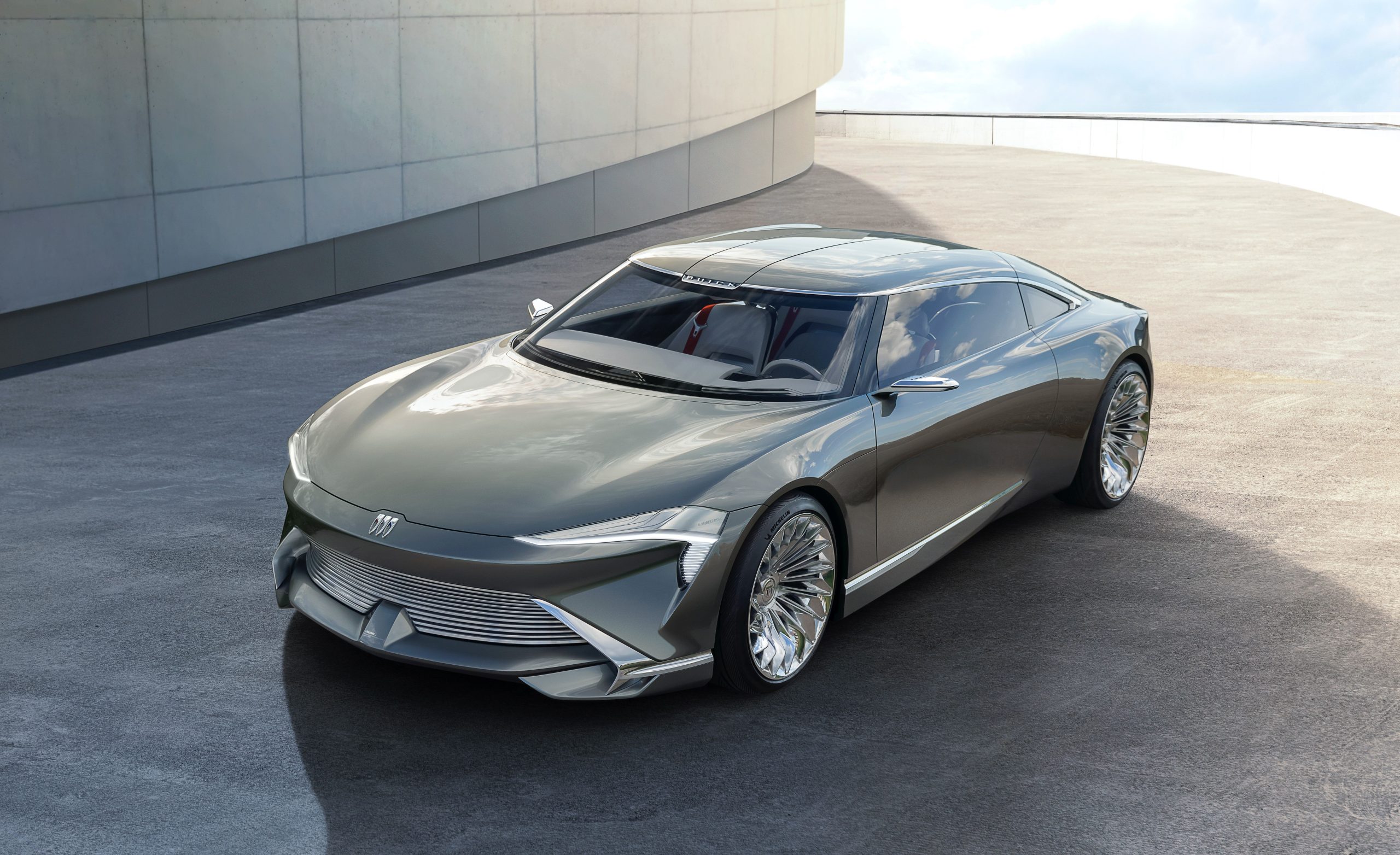
A sweeping touchscreen spans the dashboard, complemented by a rectangular steering wheel with touch-sensitive controls. Most innovative are the concept’s wellness features the vehicle can detect raised driver heart rates and automatically adjust cabin settings including seat massage, aromatherapy diffusion, and interior lighting to induce a calming effect.
While the Wildcat concept itself isn’t slated for production, it establishes key design elements that will appear on Buick’s forthcoming “Electra” series of production EVs.
These include the new tri-shield logo, uninterrupted bodyside surfacing, and distinctive lighting signatures. Built on GM’s Ultium battery platform, Buick’s production EVs will likely share technical architecture with vehicles like the Cadillac Lyriq while establishing a distinctive character through design.
The Wildcat represents Buick’s recognition that electrification offers an opportunity to redefine brand perceptions and create vehicles with more emotional appeal.
As a brand that enjoys tremendous success in China while struggling for a distinct identity in North America, Buick is leveraging the EV transition to create a more globally consistent and aspirational image blending American design heritage with forward-looking technology.
8. Lucid Air Alpha Prototype
The Lucid Air Alpha prototype represented a watershed moment for American automotive startups, demonstrating that new entrants could potentially surpass established manufacturers in developing cutting-edge electric luxury vehicles.
First revealed as a development prototype before the production Air reached customers, the Alpha version showcased Lucid’s proprietary technology and established design direction while proving the company’s engineering capabilities.
The Alpha prototype’s exterior established Lucid’s minimalist luxury aesthetic with a sleek, aerodynamically optimized silhouette achieving a remarkably low drag coefficient below 0.21.
The distinctive front fascia featured micro-lens array headlights with thousands of individual light sources creating both illumination and visual signature.
The greenhouse emphasized spaciousness with a continuous glass canopy extending from the windshield to the rear window, while flush door handles and minimized panel gaps demonstrated fanatical attention to aerodynamic detail.
Inside, the Alpha prototype introduced Lucid’s “Space Concept” an approach to maximizing interior volume through miniaturized powertrain components and thoughtful packaging.
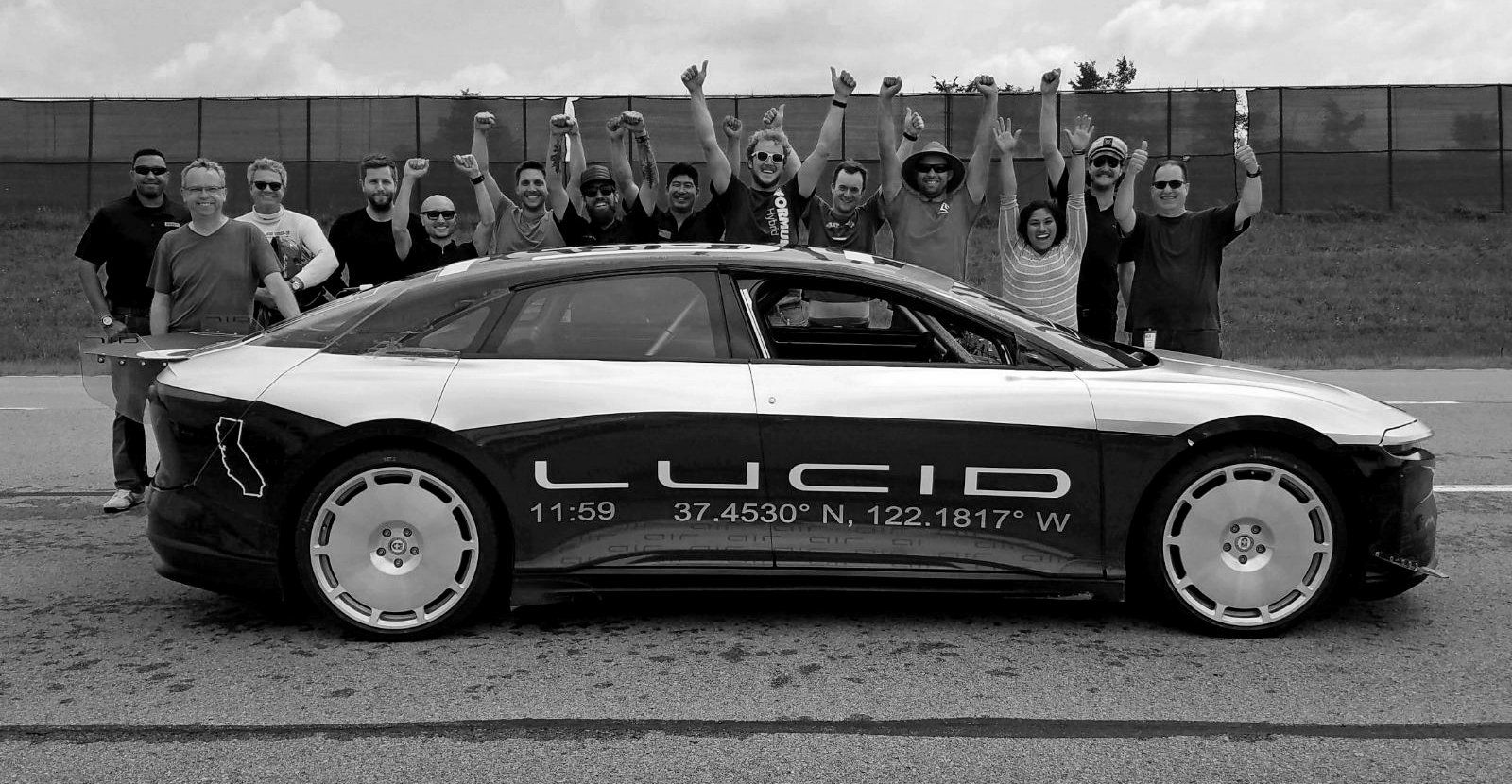
The prototype featured a floating 34-inch curved display complemented by a retractable pilot panel for secondary controls. Premium materials including sustainable open-pore wood, aluminum with microscopic perforations for speaker covers, and bridge-of-weave textiles demonstrated Lucid’s ambition to establish new standards for American luxury.
Technologically, the Alpha prototype showcased Lucid’s in-house developed compact electric motors, power electronics, and battery technology.
The 900+ volt electrical architecture allowed for unprecedented charging speeds, while the power density of Lucid’s drive units set new benchmarks for efficiency.
The prototype demonstrated over 400 miles of real-world range and acceleration capabilities below 2.5 seconds for 0-60 mph runs. Perhaps most significantly, the Alpha prototype served as proof that the vision of Lucid’s leadership team many formerly with Tesla, Mazda, and established automakers could translate into a cohesive, high-performance vehicle.
Unlike many automotive startups that showcase concept vehicles far removed from production feasibility, the Alpha prototype demonstrated remarkably production-representative technology that would later reach customers in the award-winning production Air.
The Alpha prototype thus represents a new model of American automotive innovation: combining Silicon Valley technology approaches with traditional automotive engineering expertise to create vehicles that advance the state of the art.
9. Rivian R1T Prototype
The Rivian R1T prototype marked the emergence of a distinctly American approach to electric vehicle development, focusing on adventure-oriented utility rather than urban luxury.
First revealed at the 2018 Los Angeles Auto Show alongside its SUV sibling the R1S, the R1T prototype introduced Rivian as a new kind of automotive startup one targeting the heartland of American vehicle preferences with an electric pickup truck designed for outdoor enthusiasts.
The R1T prototype’s exterior established Rivian’s signature design language, featuring a distinctive “stadium” headlight arrangement spanning the full width of the front fascia with two vertical oval elements containing hundreds of LEDs.
The clean, minimalist body surfacing avoided the aggressive styling elements typical of conventional pickup trucks, instead presenting a sophisticated yet capable aesthetic.
The prototype showcased unique functional elements including a full-width front trunk, a gear tunnel storage space behind the cab, and an integrated tonneau cover for the cargo bed.
The interior of the prototype introduced Rivian’s approach to premium utility, featuring sustainable materials like natural-grained ash wood and environmentally conscious textiles and carpeting made from recycled materials.
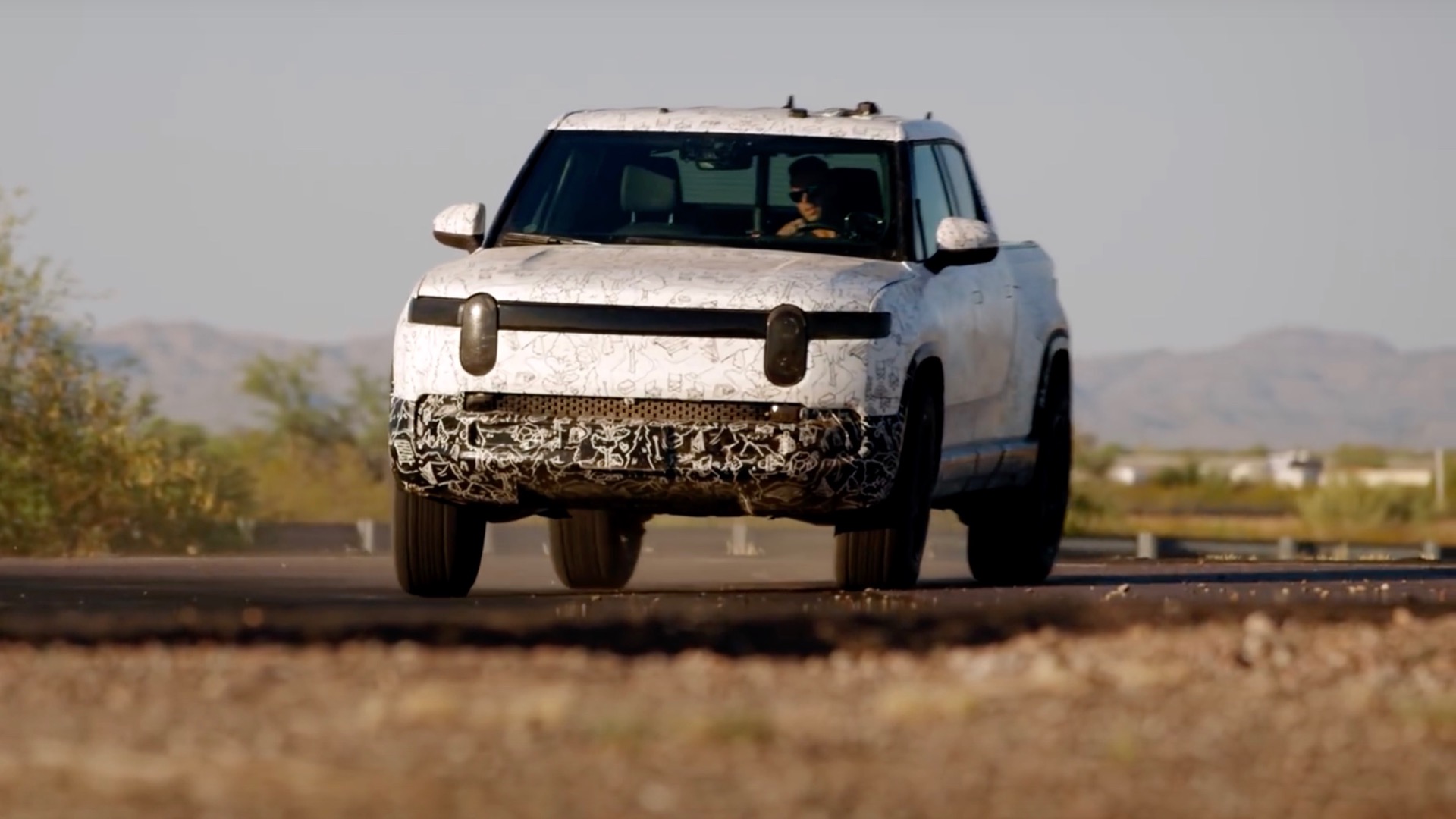
The prototype’s minimalist dashboard centered around a 16-inch center display complemented by a 12-inch digital instrument cluster, while thoughtful storage solutions demonstrated Rivian’s understanding of adventure vehicle requirements.
Technologically, the R1T prototype introduced Rivian’s “skateboard” platform architecture a flat battery pack with protective underbody shielding, four independent electric motors (one per wheel), and adaptive air suspension providing up to 14 inches of ground clearance.
The prototype demonstrated the inherent advantages of this architecture for off-road capability, including precise torque vectoring for enhanced traction and the ability to perform “tank turns” by driving wheels on opposite sides in contrary directions.
Unlike many concept vehicles that undergo significant changes before production, the R1T prototype proved remarkably representative of the eventual production model.
This reflected Rivian’s strategy of developing production-intent vehicles rather than speculative concepts an approach facilitated by substantial funding from investors including Amazon and Ford.
The prototype thus represented not just a vehicle but a carefully considered business strategy targeting a uniquely American market segment previously untapped by EV manufacturers.
The R1T prototype’s influence extends beyond Rivian itself, accelerating incumbent automakers’ plans for electric trucks and establishing adventure capability as a key competitive dimension in the electric vehicle market.
10. Canoo Lifestyle Vehicle Prototype
The Canoo Lifestyle Vehicle prototype represents perhaps the most radical rethinking of American automotive architecture since Chrysler’s original minivan.
Emerging from a California-based startup founded by former BMW executives, the Canoo introduces a “post-SUV” approach to mobility that prioritizes interior space efficiency and urban utility within a compact footprint.
The Lifestyle Vehicle’s most immediately distinctive feature is its pod-like exterior design, resembling what the company describes as a “loft on wheels.”
The dramatically upright windshield, flat sides, and squared-off rear create a silhouette unlike any contemporary production vehicle. This form follows function, with the cabin space maximized through a cab-forward design enabled by the compact electric powertrain.
Perhaps most distinctive is the vehicle’s face a simple, friendly expression created through minimalist lighting elements that communicate the vehicle’s status and intentions to pedestrians and other road users.
Inside, the prototype showcases Canoo’s “furniture-inspired” approach to automotive interiors. The rear seating area features a wraparound bench reminiscent of residential sectional sofas, accommodating up to seven passengers or reconfiguring for various lifestyle needs.
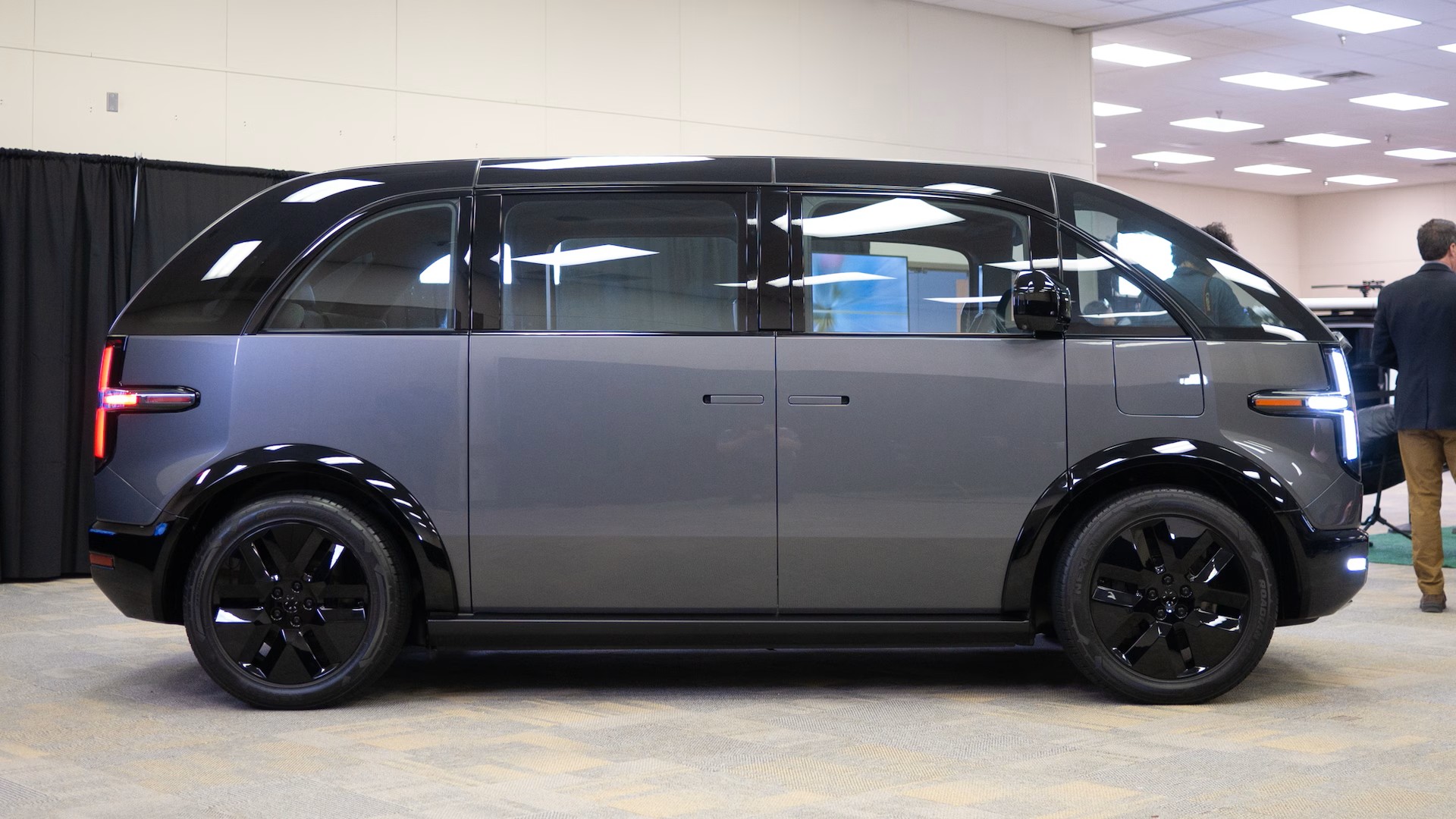
The dashboard eschews traditional instrumentation entirely in favor of minimal displays and a central tablet for essential information, while physical controls are limited to steering and pedals. The spacious, flat floor creates a living room-like atmosphere enhanced by panoramic windows and skylights.
Technologically, the Lifestyle Vehicle prototype introduces Canoo’s proprietary “skateboard” platform a complete self-contained rolling chassis that houses all critical vehicle components including battery, motors, and suspension.
This platform approach offers exceptional flexibility, allowing multiple vehicle types to be built on identical underpinnings. The by-wire steering and braking systems eliminate mechanical connections, creating additional interior space and enabling future autonomous capabilities.
What makes the Canoo Lifestyle Vehicle particularly significant as an American concept is its reimagining of the utilitarian vehicle for modern urban and suburban use cases.
Where traditional American utility vehicles emphasize size and power, Canoo focuses on spatial efficiency and accessibility values increasingly important in densifying urban environments.
The company’s business model is equally innovative, with plans for subscription services rather than conventional ownership and direct-to-consumer sales approaches that challenge established automotive retail models.
While production timing has shifted with business developments, the Lifestyle Vehicle prototype represents a distinctly American approach to automotive innovation: pragmatic in its focus on utility while bold in its willingness to abandon convention.
11. GM Cadillac InnerSpace Concept
The Cadillac InnerSpace concept represents General Motors’ most forward-looking vision for autonomous luxury mobility, reimagining the automobile as a private sanctuary rather than a transportation tool.
Revealed as part of Cadillac’s Halo Concept Portfolio, the InnerSpace explores how the absence of driving responsibilities might transform both vehicle architecture and the luxury experience when fully autonomous technology becomes viable.
The InnerSpace’s exterior design abandons traditional automotive proportions in favor of a dramatically low-slung silhouette reminiscent of personal luxury coupes from Cadillac’s history, but thoroughly modernized with active aerodynamic elements, massive articulating doors, and wheels pushed to the extreme corners.
Most strikingly, the roof and side glass form a single continuous canopy that lifts upward for ingress and egress eliminating B-pillars while creating a theatrical entry experience befitting a premium vehicle.
Inside, the concept rejects conventional automotive interior architecture entirely. The absence of manual driving controls allows for a two-passenger loveseat that spans the full width of the cabin, providing a shared experience more akin to private theater seating than traditional automotive arrangements.
Where a dashboard would typically reside, an immersive panoramic LED display wraps around the occupants. This screen can display entertainment content, augmented reality information about passing landmarks, or be minimized entirely to enhance the view through the expansive glass.
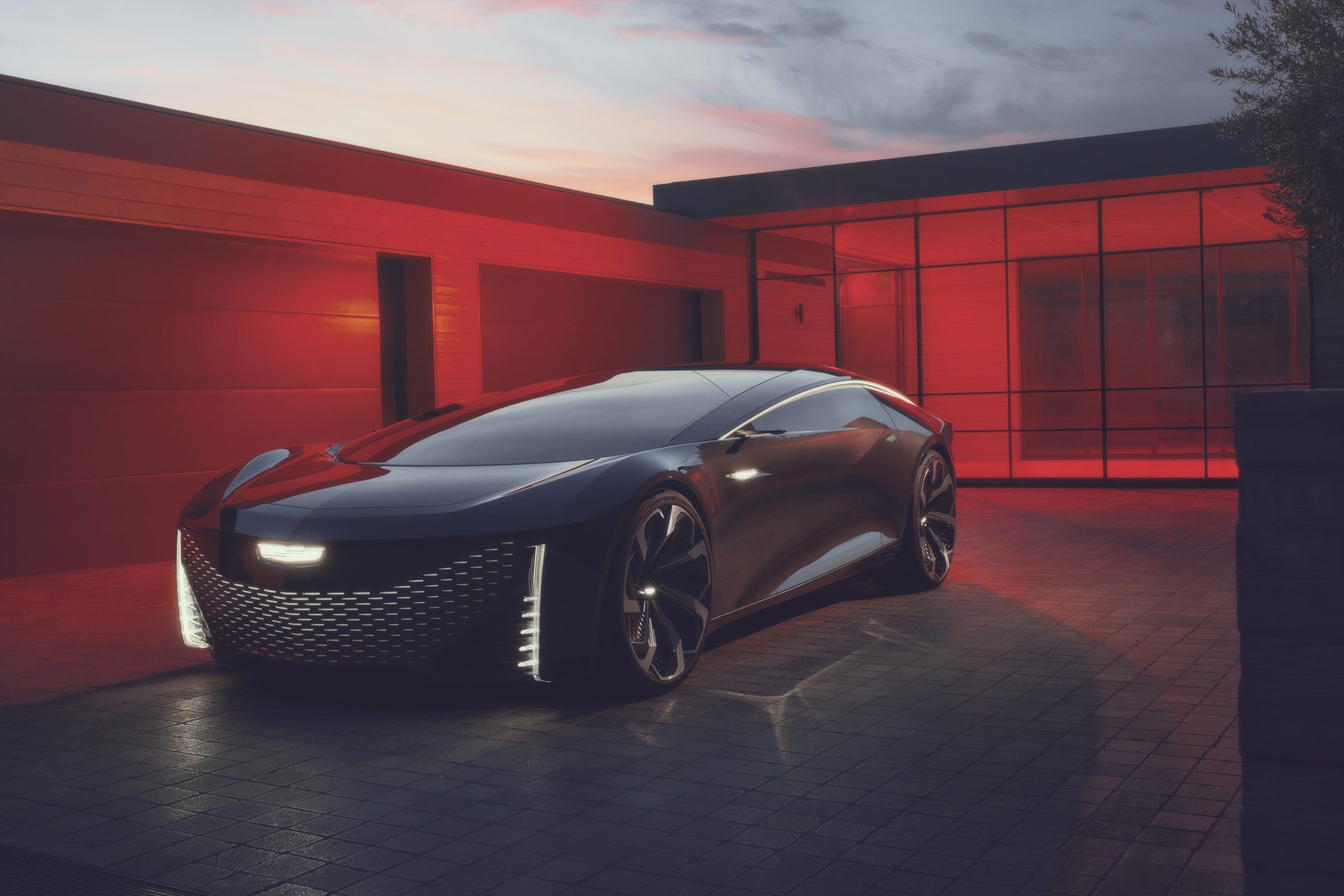
Technologically, InnerSpace showcases GM’s Ultium battery platform in a new application optimized for low-height architecture.
The batteries are distributed throughout the vehicle rather than concentrated in a single floor-mounted pack, allowing for the dramatically low seating position.
Wireless battery management systems and advanced miniaturized motors contribute to the spacious interior volume, while AI-driven software creates personalized experiences based on occupant preferences.
The InnerSpace represents a significant philosophical statement about American luxury in the autonomous age.
Rather than focusing on productivity during commuting time a common theme in autonomous vehicle concepts Cadillac emphasizes personal wellness, connection between occupants, and the luxury of unstructured time.
This distinctly American perspective on luxury as personal freedom rather than ostentation or efficiency suggests how established luxury brands might differentiate themselves in an era when driving engagement becomes optional rather than central to the ownership experience.
While the InnerSpace will never see production in its concept form, elements of its approach to passenger experience and interior architecture will likely influence Cadillac’s path toward increasingly autonomous luxury vehicles.
12. Fisker Ocean Prototype
The Fisker Ocean prototype represents a distinctly American approach to sustainable mobility that prioritizes emotional design and lifestyle integration alongside environmental responsibility.
Developed by renowned automotive designer Henrik Fisker’s second automotive venture, the Ocean prototype demonstrated how electric SUVs could transcend utilitarian approaches to sustainability through distinctive design and thoughtful features targeting active, environmentally conscious consumers.
The Ocean prototype’s exterior design established a muscular yet sophisticated aesthetic with distinctive elements including a central radar sensor integrated into the front fascia rather than hidden behind bodywork, a wraparound windshield inspired by fighter jets, and a strong character line running the vehicle’s length.
Most innovative was the prototype’s “California Mode” a single-button feature that opens all windows including the rear quarter windows, rear hatch glass, and optional solar roof to create an open-air driving experience resembling a convertible SUV.
Inside, the prototype showcased Fisker’s commitment to sustainable luxury through innovative materials including carpeting made from recycled fishing nets recovered from oceans, vegan interior options, and repurposed rubber waste from tire manufacturing.
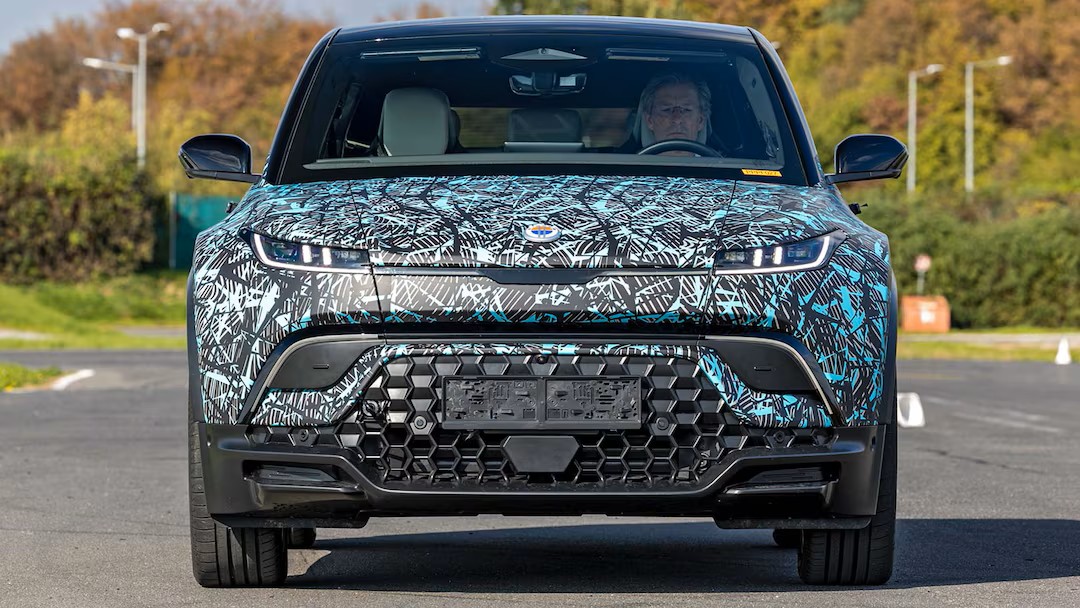
The centerpiece of the interior was a revolving center display that could switch between portrait “Control Mode” for driving and world “Hollywood Mode” for entertainment when parked.
A distinctive sculptural interior design language with angular elements and premium textures demonstrated that sustainable materials need not compromise aesthetic appeal.
Technologically, the Ocean prototype introduced several innovations including a solar roof capable of generating enough electricity for approximately 1,500 miles of additional range annually in optimal conditions.
The prototype showcased bidirectional charging capability, allowing the vehicle to power external equipment or feed energy back to the home or grid. A range of approximately 250-350 miles depending on battery configuration demonstrated competitive capabilities within the electric SUV segment.
What distinguishes the Fisker Ocean prototype from many concept vehicles is how quickly and faithfully it transitioned to production reality.
Unlike many startups that struggle with the transition from concept to manufacturing, Fisker employed an asset-light business model contracting with Magna Steyr for production.
The prototype thus represented not just a design study but a production-intent vehicle demonstrating how entrepreneurial American automotive ventures could potentially accelerate the industry’s transition toward sustainability while preserving the emotional connection consumers have with their vehicles through distinctive design and lifestyle-oriented features.
Also Read: 10 EVs With the Best Fast-Charging Speeds & Advanced Battery Technology

